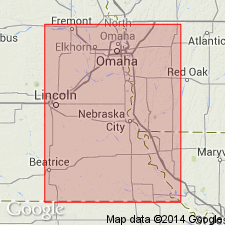
- Usage in publication:
-
- Iowa Point shale bed
- Modifications:
-
- Original reference
- Dominant lithology:
-
- Shale
- AAPG geologic province:
-
- Forest City basin
Summary:
Pg. 40, 43, 51, 102. Iowa Point shale bed of Calhoun shale member of Shawnee formation. Top bed of Calhoun shale. Consists of (at type section in Missouri River bluff just east of Iowa Point, Kansas), (descending): (1) bluish argillaceous bedded to massive shale, with carbonaceous flakes and plant leaves; (2) blue to brownish shale with some sand, becoming a loose sandstone at places; (3) bluish to brownish bedded argillaceous shale. Thickness 10+/- feet at Iowa Point, Kansas, Forest City, Missouri, and southeastern Nebraska. Underlies Curzen [Curzon] limestone (basal bed of Topeka limestone) and overlies Meadow limestone. Age is Pennsylvanian (Missouri age). Report includes cross sections, measured sections, geologic maps, stratigraphic tables.
Source: US geologic names lexicon (USGS Bull. 896, p. 1020-1021); GNC KS-NE Pennsylvanian Corr. Chart, sheet 1, Oct. 1936; supplemental information from GNU records (USGS DDS-6; Denver GNULEX).

- Usage in publication:
-
- Iowa Point shale bed
- Modifications:
-
- Contact revised
- AAPG geologic province:
-
- Nemaha anticline
Summary:
Pg. 47. Iowa Point shale bed of Calhoun shale member of Shawnee group. Consists of 5 to 6 feet of bluish-green, argillaceous, somewhat calcareous shale that weathers yellowish. The top 6 inches to 1 foot contains many DERBYA CRASSA and other brachiopods, along with some fenestrated bryozoans. Stated that true Meadow limestone belongs down in Stanton limestone, and he applied Sheldon limestone to the limestone underlying Iowa Point shale and overlying Jones Point shale. Age is Pennsylvanian.
Source: US geologic names lexicon (USGS Bull. 896, p. 1020-1021); GNC KS-NE Pennsylvanian Corr. Chart, sheet 1, Oct. 1936; supplemental information from GNU records (USGS DDS-6; Denver GNULEX).
For more information, please contact Nancy Stamm, Geologic Names Committee Secretary.
Asterisk (*) indicates published by U.S. Geological Survey authors.
"No current usage" (†) implies that a name has been abandoned or has fallen into disuse. Former usage and, if known, replacement name given in parentheses ( ).
Slash (/) indicates name conflicts with nomenclatural guidelines (CSN, 1933; ACSN, 1961, 1970; NACSN, 1983, 2005, 2021). May be explained within brackets ([ ]).

